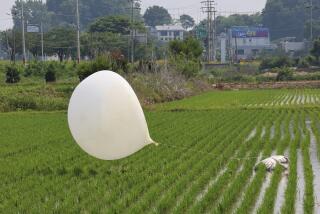Disney’s Balloon Barrage--What Goes Up, Must . . .
If all goes according to schedule, 1,209,600 brightly colored nine-inch balloons will rise into the sky above Anaheim this afternoon. A tribute to Walt Disney and Disneyland by the community of Anaheim on the 30th anniversary of “the happiest place on earth,” this helium-filled flock will undoubtedly be a sight to make the spirits soar. Some people are wondering, however, what will happen when what went up, comes down.
Even as the evening news is replaying what’s billed as the biggest balloon launch in history, might not some unsuspecting locale downwind of the Magic Kingdom find itself pelted by a gaily colored rain of latex?
“It’s kind of a shame, someone’s always looking for the negative angle,” grumbled Al Flores, supervisor of publicity at Disneyland.
No one can predict for certain where or how far the winds will carry the balloons, Flores said. He added, though, that from experience with balloon releases at Disneyland, “They always go in a northeasterly pattern.”
Wouldn’t that seem to suggest that many if not most of the balloons will descend somewhere in the Mojave Desert? Might that not give new meaning to the term “painted desert?”
No environmental groups have contacted Disneyland with concerns about any potential litter problem, Flores said. And besides, he explained, the balloons being used are natural latex. “They’re 100% biodegradable.”
So how long might it take a balloon to decompose?
“I don’t have any idea,” said Ted Vlamis, the president of Pioneer Balloons of Wichita, Kan., who is in Southern California to watch the launch of the balloons his company made.
Judging from a series of telephone calls, not many people do know much about the decomposition rate of latex. Kieran Bergin, a Los Angeles County hazardous waste engineer who wound up on the other end of the line after a reporter’s inquiry went through a dizzying series of transfers and referrals, explained that there are at least 15 common types of latex, which is “a watery emulsion of rubber.” According to one government study, they range from poor to excellent in their ability to stand up to the forces of nature. But the study didn’t say how long a poor or excellent variety of latex might actually last.
“We don’t normally think of rubber as a hazardous waste,” Bergin said, to explain his lack of knowledge on the subject. As an afterthought he added: “I do know that I don’t find my tires missing when I go out to my car in the morning.”
Asked the same question about the life expectancy of latex, balloon-event mastermind Treb Heining replied: “I’m sure it’s quick.” Heining engineered, among other events, the big release at the ’84 Olympics.
Gone Forever
Does he have any concerns about his artistic endeavor’s effect on the environment?
“None whatsoever. Once the balloons are launched, they’ll either go out to the ocean or the desert. I’m certain they’ll never be seen again.”
Environmentalists active in desert conservation issues weren’t so sure of that.
“Gadzooks!” exclaimed Scott Simons, of Pinon Hills, a member of the Sierra Club’s Desert Task Force. “This is a new one on me. There’s so many threats out there; this one’s truly from left field.
“I guess if they all come down reasonably close together, because of a down draft maybe, and they land in a box canyon, you could have a real cleanup problem. I don’t know, I mean it’s a big desert.”
But his main concern, Simon said, was for wildlife.
“I wonder how tortoises would fare on a latex diet? They might see something bright that looks like a cactus flower and eat it.” According to a recent study that he read, serious problems can result when desert animals eat litter, Simon added.
Most of the California Department of Fish and Game’s wildlife pathologists were out on a sheep roundup. Wildlife biologist Don Coch, in the Sacramento office, said that he had no expertise in such matters but pointed out that from his observations, “Bear eat the plastic survey flagging the Forest Service puts out all the time, and it’s in one end and out the other with no apparent harm.”
Broader Concerns
Peter Burk, who lives in Barstow and is an active member of the Friends of the East Mojave, had broader concerns.
“Maybe there needs to be an environmental impact statement. . . . For instance, what does latex do when it falls on creosote brush. How will it affect the water supply?” The more he thought about the balloon launch, the more annoyed Burk became. “The desert’s not a dump. . . . We don’t have any plans to dump a lot of trash on Disneyland, and we hope they’ll treat us in the same way.
“There are a lot of wilderness study areas out here that we’re trying to preserve in their natural state,” he continued. “If they want to release balloons, they should be willing to send someone into these remote areas to pick them up--regardless of the decomposition rate. . . . We do this constantly, picking up trash. We don’t need an additional burden.”
As Burk sees it, it really doesn’t matter if the balloons fall back to earth in Barstow or Antarctica. “There’s going to be trash dumped somewhere.”
“It sounds like it will be a big thrill for a couple seconds in Anaheim, then we’ll have trash strewn everywhere. . . . We should try and clean up our litter and trash instead of adding to the problem.”
Hearing of these objections, Sheri Erleweine, publicist for the City of Anaheim and “balloon logistics coordinator extraordinaire” for the event, replied: “The balloons are biodegradable and will be consumed by Mother Nature. We hope it doesn’t cause any inconvenience, but there is no health threat to animals or the environment.”
Sally Reid, a member of the Sierra Club’s board of directors, doesn’t necessarily agree. “A million balloons will do less damage than a million bottles or a million cans,” she said. “But we still wish they wouldn’t intrude.”
More to Read
Sign up for Essential California
The most important California stories and recommendations in your inbox every morning.
You may occasionally receive promotional content from the Los Angeles Times.










